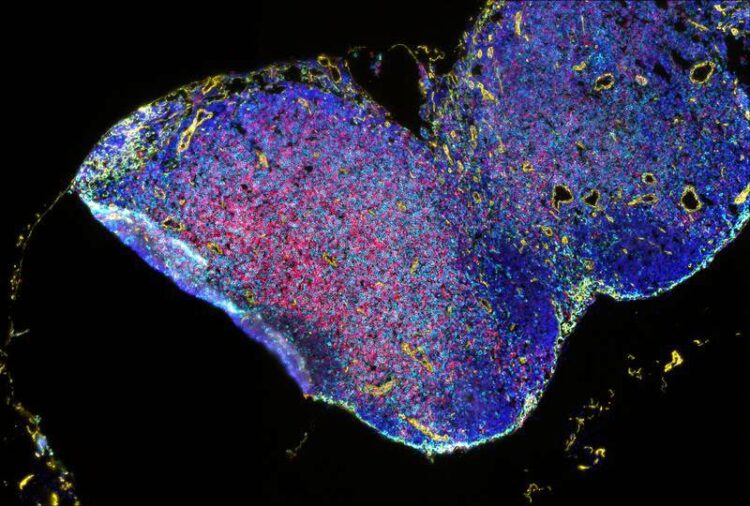Artificial intelligence to help tumor immunology

Mouse lymph nodes: The colors represent fluorescent markers that bind to specific molecules on the surface or inside individual immune cells.
Image: AG Hoelzel/UKB
The success of cancer treatment depends not only on the type of tumor, but also on the surrounding tissue. Tumors influence it to their advantage, promoting the growth of blood vessels or fooling incoming immune cells.
Developing methods to predict the nature of the resulting tumor microenvironment is the goal of researchers from the Clusters of Excellence ImmunoSensation2 and the Hausdorff Center for Mathematics (HCM) led by Prof. Kevin Thurley at the University of Bonn. The German Federal Ministry of Education and Research (BMBF) is funding the “InterpretTME” project with around 800,000 euros over the next three years.
Cancer treatment has been revolutionized in the past decade by new methods of immunotherapy. This involves not attacking a tumor directly, but rather using the existing cells of the immune system. These are usually able to recognize and eliminate malignant tumor cells. However, many tumors have the ability to prevent or severely limit an effective immune response. Immunotherapy aims to restore the misguided immune system’s ability to recognize and destroy tumor cells.
The role of the tumor microenvironment
Immunotherapy against cancer is not successful in all patients. Resistance to cancer immunotherapies has been shown to be frequently associated with tumor microenvironment (TME) composition. In oncology, the properties of the TME are already being used as biomarkers to make predictions about how a cancer will develop. This is done using imaging techniques that map the type and location of individual cells within the TME. Patterns of gigantic cell assemblies emerge, which in their totality and structure influence the success or failure of cancer immunotherapy. How exactly this works, however, remains elusive.
“New high-resolution imaging techniques have shown that disease mechanisms are indeed related to details of the spatial arrangement of specific cell types in tissues,” notes Prof. Kevin Thurley of the Institute of Experimental Oncology at the University Hospital Bonn. “Using a combination of mathematical modeling and artificial intelligence methods, we will investigate these phenomena in detail, in direct collaboration with experimental and clinical research at our University Hospital.”
Artificial intelligence for tissue analysis
Artificial intelligence (AI)-based methods for image analysis are already well advanced today. The situation is different when simulating complex systems, due to the large number of interacting cells within a tissue. Given the multitude of cell types involved, the different cellular processes taking place there, and the complex tissue architecture, such a simulation requires extremely high computational resources. However, it can help to simulate the TME of a tumor and thus draw conclusions about tumor development.
Insights into immunotherapy through machine learning
The overall goal of “InterpretTME” is to develop interpretable machine learning (ML) methods for studying complex cellular systems. These are to be used to gain insights into the nature of TMEs. “Machine learning is already used in many places in the hospital to process image data,” explains Prof. Jan Hasenauer, of the Life & Medical Sciences Institute (LIMES) at the University of Bonn. “We will go one step further and investigate the extent to which information about mechanisms can also be obtained.” One aim is to investigate the role that individual immune cell types present in the TME play in the development of different tumor types. In addition, the researchers want to determine what effect chemotherapeutic agents and biological drugs have on the TME of different tumor types. Prof. Michael Hölzel and Prof. Marieta Toma from the University Hospital Bonn and Prof. Alexander Effland from the University of Bonn are also involved in the project.
Media contact:
Dr. David Fußhöller
Cluster of Excellence ImmunoSensation2
University of Bonn
Tel. (+49) 228 287 512 83
E-mail: David.fusshoeller@uni-bonn.de
Media Contact
All latest news from the category: Medical Engineering
The development of medical equipment, products and technical procedures is characterized by high research and development costs in a variety of fields related to the study of human medicine.
innovations-report provides informative and stimulating reports and articles on topics ranging from imaging processes, cell and tissue techniques, optical techniques, implants, orthopedic aids, clinical and medical office equipment, dialysis systems and x-ray/radiation monitoring devices to endoscopy, ultrasound, surgical techniques, and dental materials.
Newest articles

Innovative 3D printed scaffolds offer new hope for bone healing
Researchers at the Institute for Bioengineering of Catalonia have developed novel 3D printed PLA-CaP scaffolds that promote blood vessel formation, ensuring better healing and regeneration of bone tissue. Bone is…

The surprising role of gut infection in Alzheimer’s disease
ASU- and Banner Alzheimer’s Institute-led study implicates link between a common virus and the disease, which travels from the gut to the brain and may be a target for antiviral…

Molecular gardening: New enzymes discovered for protein modification pruning
How deubiquitinases USP53 and USP54 cleave long polyubiquitin chains and how the former is linked to liver disease in children. Deubiquitinases (DUBs) are enzymes used by cells to trim protein…



